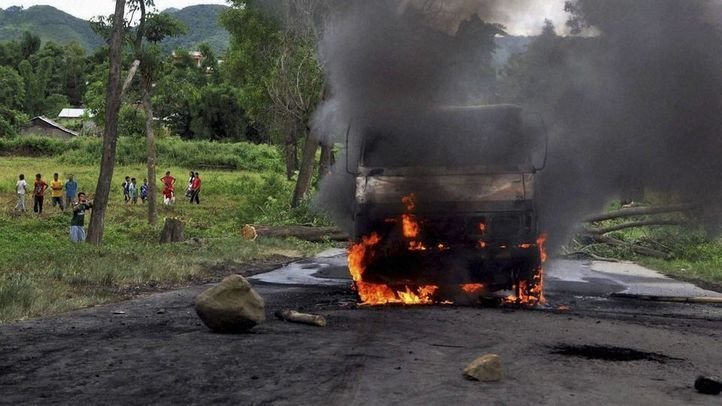Tens of thousands of tribal women in Manipur’s Churachandpur district on Saturday, September 19, formed a 12-kms long human chain in protest against one of the the three Anti-Tribal Bills ie the Land Reform Bill, and demanded action against the police personnel responsible for the death of 9 protesters who were killed during the violence that broke out after the passing of bills by Manipur State Assembly on August 31, The Sangai Expr ess , Manipur’s leading English daily reported.
Braving rain shower, the women, clad in black mostly, gathered and joined hands to form a chain from Kangvai to Churachandpur district hospital in Lamka town – a distance of 12 kilometers – where they observed a minute long silence for those killed in the recent violence.

The protest was organized by Joint Action Committee (JAC) which has been formed to spearhead the people’s movement against the Anti-Tribal Bills, with women at the fore-front of this agitation. JAC has been demanding a complete repeal of the bills.
A report in Kangla Online said that a 75-year old woman from Koite Village also took part in the demonstration.
JAC convenor H Mang-chinkhup said the human chain protest was aimed at telling the government and the world that, “we are against the three Bills that have been passed by the State Government, and that we want them repealed immediately.”
What is ILP?
Introduced by British government, Inner Line Permit (ILP), is a mechanism applicable in the Northeast states of Arunachal Pradesh, Nagaland and Mizoram according to which a special pass is required to enter these states. The mechanism is essentially used to limit the exposure of tribals and their cultures from onslaughts by outsiders, a Hindustan Times report says.
However, Manipur and Meghalaya, with a substantial population of tribals in hill districts, have seen sporadic demands for its implementation, a report in The Indian Express says.
A joint committee on ILP was established on July 4, 2012 to demand immediate implementation of the Inner Line Permit system in Manipur to protect the “future” of the indigenous population of Manipur. It said in the 2001 census, Manipur had a population of 22,93,896, of which outsiders accounted for over 7 lakh, a report in The Telegraph notes.

But the agitation in Manipur for ILP escalated after 17-year-old Robinhood Sapam was killed by a teargas shell fired by the police at protesters on July 8.
Despite assurances by the government and its withdrawal of the Manipur Regulation of Visitors, Tenants and Migrant Workers Bill, 2015 – a bill that proposed to register all visitors, tenants and migrant workers with the directorate of regulation of visitors and tenants, which would be set up under the proposed act and state labour department – and which the JCILP had strongly opposed on the grounds that it didn’t fulfill the demand for the ILP.
According to the committee the “bill did not have teeth to safeguard the interests of the indigenous people,” another report in The Telegraph reads.
The insecurity of tribals
Nearly 60% of Manipur’s population of just over 27 lakh comprises Meiteis; the Naga, Kuki and Zomi tribes make up the rest. Meiteis are dominant in the Imphal valley (the four districts of Imphal West, Imphal East, Thoubal and Bishnupur), which covers only 2,248 sq km (10%) of Manipur’s total 22,327 sq km. The Meitei population is largely Hindu; the tribals are mostly Christian.
The ILP agitation was largely a Meitei demand, which tribal organisations suspected was the first step in a Meitei plan to acquire Scheduled Tribe status, so far the privileges for tribals only. The tribal population stayed away from the agitation. As their land is protected by the Constitution, Tribals perceived no threat from outsiders (or mainland Indians).

But there exists a strong discomfort between the dominant Meiteis, living in valley, and tribals , the hill people, who have traditionally felt marginalized. Meiteis control the fertile valley and its businesses, dominate the administration, and occupy 40 seats in the Assembly — double the number of Hills MLAs.
On development front the schism is more than apparent. The Hill districts are underdeveloped and poor, and tribals have for decades complained that most development funds are hogged by the valley. The Hills have only sporadic, if any, electricity supply, few roads, enterprises, and schools, and follow traditional jhoom cultivation practices, the Express report says further.
Suspicions
Meiteis can’t buy land in tribal areas, while as tribals can, and often do, buy land in the valley.
Tribal population suspects that the Manipur government, and the Meiteis, are attempting to grab the one thing that they have — their land.

The resentment against government and Meiteis is so strong that two hostile rivals Nagas and Kukis have come together to fight their ‘common enemy.’ All Tribal Students Union of Manipur is the product of that resolve.
The Meiteis’ have their grouse too. They say apart from land, 22% of government jobs are reserved for the tribes and Scheduled Castes. The pressure on land in the Imphal valley has been the main driver of the ILP agitation, as well as the reason for hostility towards tribals, the Express report states.
The violence
Manipur has been caught in a spiral of violence since passing of three bills – The Protection of Manipur People Bill, 2015, the Manipur Land Revenue and Land Reforms (Seventh Amendment) Bill, 2015, and the Manipur Shops and Establishments (Second Amendment) Bill, 2015, brought in as substitutes to introducing the Inner Line Permit or ILP, unanimously by the ruling Congress government in Manipur Assembly on August 31.

According to tribal bodies, the bills have been brought by the “communal Manipur government” to acquire tribal land in the Hill districts which is protected by Article 371C of the Constitution. Under the article, land and its resources in Hill districts are controlled by its tribal inhabitants. No non-tribal can buy land in Manipur’s tribal areas.
Tribal organisations maintain that as long as Article 371 C exists, no land Bill brought by the Manipur government can be applicable in any of the five Hill districts.
The protests are continuing unabated. Tribal bodies have decided to India’s flag to be flown half-mast in Manipur from Sept 21 to Oct 15, though the diktat is not for government institutions.
Following the collapse of British paramountcy in 1947, Manipur’s king signed a merger agreement with then Indian government, forcefully, on Sept 21, 1949.
Read more:

















